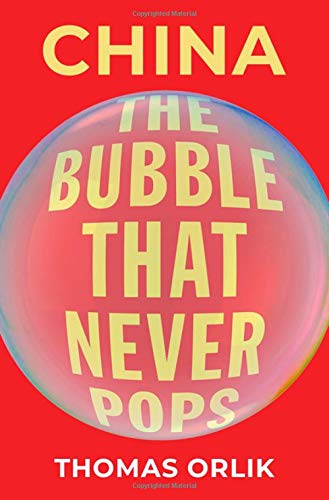Book Review: China: The Bubble that Never Pops

Bloomberg’s chief economist is Tom Orlik. In his new book, “China: The Bubble that Never Pops”
How does China defy the negative outlook.
Thomas Orlik is a veteran of more than a decade in Beijing. In this book, he dives into China’s fragile fundamentals and resources for resilience. Drawing on discussions with Communists, shadow bankers, and migrant workers, Orlik pieces together a unique perspective on China’s past, present, and possible futures.
In the history of China analysis over the last 8 years, it is a continued diet of concern that there will be a crash. China’s debt is too high, their banks are overexposed, China’s state-run enterprises have borrowed too much, their real estate sector is overbuilt.
However, it is just growth, continual growth which has prevented the last straw from breaking China’s economic back.
And so in the first few months of 2020 with the Covid-19 shock, we had a perfect storm: China’s GDP contracted 6.8% in the 1st quarter, business profits shrank, households faced unemployment, local governments faced shrinking tax revenue – if there was going to be a crises, it would have come within the last 4 or 5 months – but it hasn’t come.
The point is, the bears have it wrong. Yes, China has a lot of debt. Debt to GDP has risen from approximately 140% in 2008 to 260% today. When we see that pace of debt increase in most other countries, it is a pretty clear signal that a crisis is going to take place.
And yes, China has a lot of other problems – they are a demographic time bomb; they have a largely inefficient state sector; real estate is overbuilt.
Where the bears have it wrong is how this adds up. For this author, it doesn’t add up to a crisis. The bears overlook the things that China has on its side: A very high savings rate, which means that the banks have a very stable source of funding, and determined developmental state, which keeps finding new opportunities for growth.
These are significant positives for China. They don’t get enough attention in the conventional narrative that we get, and what they mean is that a crisis is not immanent.
Government debt: 2016 – they claim that their debt to GDP was 37%, which would be a real model of fiscal discipline – if it were true.
Beijing grabs the lion’s share of tax revenue, but it leaves the bulk of the spending responsibility to local governments. Local governments turn to other means of creating income, and most recently it has been to borrow money.
These are called “local government (LG) financing vehicles”. LG use these to get around the rules and borrow “off the books”. Because of this system, there is a huge grey area as to how much has been financed, and how much of that will show up on Beijing’s balance sheet.
The official data is debt at around 40 – 45% of GDP, very manageable.
Japan’s is much higher.
The US is much higher.
However, if you start adding on the obligations of LG financing vehicles, and what about unfunded pension obligations, you quickly get to a much higher percentage.
Beijing eventually caught on and stepped in and told them to refinance those loans, shifting the burden on to the banks.
China analysis is ahistorical, it doesn’t take in the international perspective, the similarities and differences. The comparisons can be quite illuminating.
For example, the difference between the USA and China’s joint stock banks, city banks and savings and loan banks.
The US banks dashed for growth by dodging regulations, paying a lot for their funding and chasing very high returns by making very risky investments and extending credit to risky borrowers. In the savings and loan case, the result was a crisis. Total cost – many people put it at about 3% GDP for America.
In China, the same thing could have happened, but Chinese regulators moved early and aggressively to get on top of the problem.
For the US, it is a history of regulatory failure. The treasury and other governmental bodies have more power. Alen Greenspan wrote a letter in favor of one of the most notorious savings and loans, stating that they were professionals, leave them alone, etc. In China, it is very different. When policy makers decided to act, they acted decisively. Now we can see on the books that their banks are acting pretty effectively.
China doesn’t just look at their own mistakes, they look at the mistakes in the past of other countries.
Another good book on the subject is China’s Communist Party: Atrophy and Adaptation by David Shambaugh
The absolutely critical period was the Asian Financial Crisis. In the 1990’s Korea and other countries across Asia believed the Western theory of needed open capital systems, competitive markets, and that they needed Wall Street to come in and run their financial system and their economy – and this will drive growth.
In the Asian crisis we saw that it is all very nice when the money is coming in, but what happens when the money comes out?
 The system came crashing down.
The system came crashing down.
China paid very close attention to that process. They found that there are very serious risks in opening up your economy and your financial system too quickly, and allowing those Wall Street banks to come in too aggressively.
Since then, we have seen China act more slowly and cautiously in opening up.
Mapping possible scenarios, Orlik plays out what will happens if the bubble that never pops finally does. The magnitude of the shock to China and the world would be tremendous. For those in the West nervously watching China’s rise as a geopolitical challenger, the alternative could be even less palatable.








